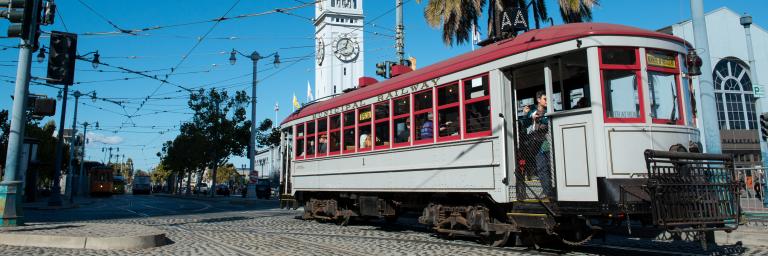Background
The story of San Francisco’s historic streetcar service begins in 1962, when the voters of Alameda and Contra Costa counties and San Francisco approved the $792 million bond issue for BART construction in November 1962. The bond issue included funds for the construction of the Market Street subway, so that Muni’s five streetcar lines could be put underground for faster service. San Francisco voters subsequently approved a bond issue for Market Street reconstruction and beautification in 1968.
At first, it was thought that almost all transit service would be removed from Market Street east of Van Ness Avenue, and it took several years before there was an official recognition of the importance of transit on this major thoroughfare. Meanwhile, transit advocates both within and outside city government began advocating for San Francisco to begin its own historic streetcar service, both on Market Street and on the city’s waterfront.
Market Street Goes Metro
The first proposal for a historic streetcar line on Market Street was made in 1971, and the first proposal for a line on The Embarcadero was made in 1974. The late Maurice Klebolt was one of the leading advocates for the historic streetcar service. In 1979, he was the person largely responsible for obtaining the first historic streetcar from another country, the now-retired #3557 from Hamburg, Germany.
Beginning in 1981, the plan called for two lines, an E Embarcadero Line and an F Line that would serve The Embarcadero and Market Street. There was historic streetcar service on Market Street on summer weekends in 1981 and 1982, before the regular streetcar service on Market had been entirely put underground. Weekday Muni Metro service in the subway had started on the N Line in February 1980. The Metro service was implemented in phases, until all five lines were in the subway on a full-time basis as of November 1982.
Trolley Festivals Seal the Deal
The Cable Car System Rehabilitation Program began in September 1982, shutting the system down until June 1984. The summer Trolley Festivals were started on Market Street in 1983 to provide an alternative historic transit service for visitors to the city, and they operated through 1987. Historic streetcars from San Francisco, other U.S. cities and other countries brought delight to many thousands of people.
The 1986 and 1987 Festivals received support from the Market Street Railway Company, a non-profit group dedicated to the acquisition, restoration and operation of historic transit vehicles in the city. The success of the Trolley Festivals ensured that there would be full-time historic streetcar service in San Francisco.
The F is Born
Construction for the Market Street Transit Thoroughfare Project took place in four separate phases from 1988 to 1995. The street improvements included streetcar track construction and the installation of new boarding islands, widened crosswalks, and new curbing, as well as the planting of palm trees in the median of Upper Market Street. September 1, 1995, was the first day of service for the F Market historic streetcar line, between Castro and Market streets and the Transbay Terminal at 1st and Mission streets.
Planning for the extension of historic streetcar service to Fisherman’s Wharf received greatly increased attention after the October 1989 earthquake and the subsequent tearing down of the Embarcadero Freeway. Construction for the F Line extension became part of the city’s Waterfront Transportation Projects for roadway and transit improvements (the Muni Metro Extension to the Caltrain depot at 4th and King streets was also one of the Waterfront Transportation Projects). Work began in July 1993 for roadway and F Line extension construction. However, the completion date for the extension was dependent on the completion of the mid-Embarcadero segment of the Waterfront Projects. Service to Fisherman's Wharf began on March 4, 2000.
From Milan with Love
Streetcars from Milan, Italy, built in 1928, were acquired by Muni for the extension of the service (now called the F Market & Wharves Line) to Fisherman’s Wharf. The cars are called “Peter Witt” cars because their design is based on one that Cleveland transit commissioner Peter Witt created for faster passenger boardings.
The first “Peter Witt” cars entered service in about 1915. They were designed so that passengers would enter by the front doors and leave by the center doors. The conductor would be in the center of the car, and passengers did not have to pay until they left the car or went to the rear, resulting in faster service since the cars did not have to wait while passengers paid to get on board.
Nine of the Milan cars are currently in service to Fisherman’s Wharf, and others will be ready for service in the future. Seventeen PCC streetcars are in regular F Line service (fourteen from Philadelphia and three from Muni). The cars are painted in the PCC colors of Muni and other transit agencies in the U.S. as their streamlined design is attractive, and they were quieter and more economical than earlier versions of streetcars, with better motors, controls, acceleration and braking.
